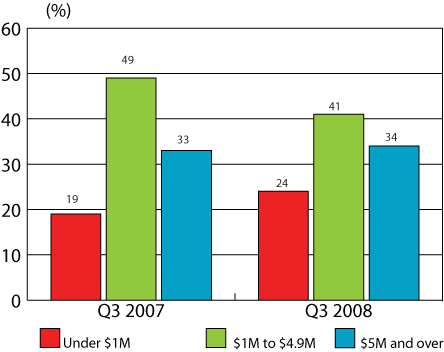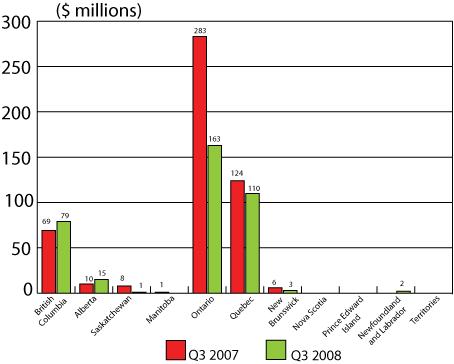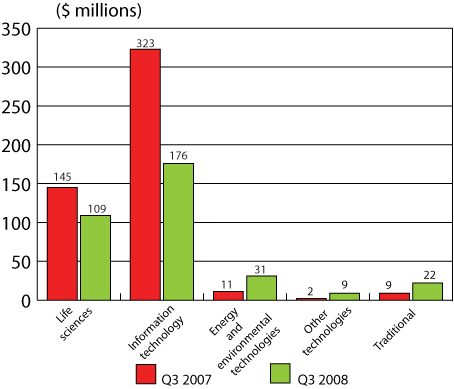PDF Version
Venture Capital Monitor - Q3 2008
82 KB, 7 pages
Canadian high growth innovative small and medium-sized enterprises (SMEs) that commercialize research depend to a large extent on the venture capital (VC) industry for funding. Therefore, a strong VC industry is important for the growth of this segment of SMEs. The goal of this series is to provide current information about the VC industry in Canada. To this end, the series will track trends in investment activity, report on topical VC-related research and look at key technology clusters where VC investment is taking place.
Introduction
This issue discusses Canada's venture capital (VC) activity during Q3 2008. It includes an article about InNOVAcorp, a Halifax-based business incubator, and the novel concept — High Performance incubation (HPi) — that applies in supporting technology-based new ventures. An article on Toronto describes the city's technology clusters.
VC activity overview
Investment and fundraising
Year-over-year investment declines in first nine months of 2008, fundraising remains flat
Venture capital (VC) investment in Canada totalled $372M (123 deals) in Q3 2008, down 26 percent from $501M (140 deals) invested in Q3 2007 (Table 1). Most of this decrease can be explained by one large US$100M deal made in Q3 2007. On a quarter-by-quarter basis, VC investment increased 22 percent in Q3 2008 from $304M (108 deals) recorded in Q2 2008. This brings total investment during the first nine months of the year to $1.0 billion, down 33 percent from $1.5 billion invested during the same period in 2007.
| Q3 2007 | Q3 2008 | % Change | |
|---|---|---|---|
| ($ millions) | |||
| Source: Thomson Reuters 2008. | |||
| Investment | 501 | 372 | -26 |
| Fundraising | 113 | 114 | 1 |
Canadian VC fundraising reached $114M in Q3 2008, almost the same level observed in Q3 2007 but a decrease compared with $356M raised in Q2 2008. Fundraising in the first nine months of 2008 totalled $886M, roughly equal to $889M raised during the same period last year but significantly lower than any other year since the late 1990s.
Deal size
Slight increase in smaller deals
The average size of VC deals in Canada was $3.0M in Q3 2008, down 17 percent from $3.6M recorded in Q3 2007. This difference can be explained by one unusually large deal in Q3 2007 valued at US$100M that was made by a syndicate of American VC funds. In contrast, the largest deal in Q3 2008 was worth $38M. As well, there were proportionately more deals in Q3 2008 that were worth less than $1M (Figure 1).
Figure 1
Distribution of deals by size, Q3 2007 and Q3 2008

Source: Thomson Reuters 2008.
Stage of development
Decline in late-stage investment
The decline in Q3 2008 in overall VC investment compared with Q3 2007 is largely due to a drop in investment in late-stage companies. The $193M (72 deals) in late-stage VC investment in Q3 2008 is comparable to levels observed in the previous two quarters, but 41 percent lower than $329M (75 deals) observed in Q3 2007 (Figure 2).
Figure 2
VC investment by stage of development, Q3 2007 to Q3 2008

Source: Thomson Reuters 2008.
The drop in late-stage VC investment in 2008 compared with 2007 is related to a reduction in very large investments by foreign sources. In the first three quarters of 2008, foreign investors made late-stage investments totalling $181M (42 deals), less than half the $486M (40 deals) invested during the same period in 2007. This difference is largely because in the first three quarters of 2007 there were three U.S.-backed late-stage deals worth $160M, US$100M and US$53M, respectively, whereas in 2008 there have been no announced deals larger than $45M. Because such a small number of deals caused the decrease, it is not possible to conclude whether the decrease in late-stage foreign investment is due to an underlying trend or just natural variation.
The $55M (24 deals) invested in seed and start-up companies in Q3 2008 is roughly equivalent to levels reached in the first two quarters of 2008, but down 28 percent from $76M (31 deals) invested in Q3 2007. In contrast, the amount invested in companies at "other early stages"Footnote 1 of development increased dramatically in Q3 2008, reaching $124M, much higher than $66M invested in those companies in Q2 2008 and $97M invested in Q3 2007.
New versus follow-on investments
New investments increase compared with last quarter
Forty-eight companies received VC for the first time in Q3 2008, more than doubling the 21 firms that received "new" VC in Q2 2008, but down nine percent from 53 new deals in Q3 2007. The number of follow-on deals dropped to 75 in Q3 2008, down 14 percent from 87 follow-on deals in Q2 2008 and 87 follow-on deals in Q3 2007 (Table 2).
| Q3 2007 | Q4 2007 | Q1 2008 | Q2 2008 | Q3 2008 | ||
|---|---|---|---|---|---|---|
| Source: Thomson Reuters 2008. | ||||||
| New | All | 53 | 44 | 44 | 21 | 48 |
| Seed/start-up | 23 | 14 | 20 | 9 | 16 | |
| Other early stages | 6 | 5 | 5 | 1 | 3 | |
| Later stage | 24 | 25 | 19 | 11 | 29 | |
| Follow-on | All | 87 | 86 | 85 | 87 | 75 |
| Seed/start-up | 8 | 10 | 16 | 15 | 8 | |
| Other early stages | 28 | 22 | 26 | 19 | 24 | |
| Later stage | 51 | 54 | 43 | 53 | 43 | |
Notably, 16 (or one third) of the companies that received VC investment for the first time in Q3 2008 operated in traditional sectors in Quebec.
Type of investor
The amount invested in Canada by foreign funds totalled only $98M (18 deals) in Q3 2008, less than half the $209M (23 deals) invested by foreign funds in Q3 2007 (Table 3). As noted earlier, this difference can be explained mainly by a US$100M deal made by a syndicate of American VC funds in Q3 2007.
| Q3 2007 | Q3 2008 | % Change | |
|---|---|---|---|
| ($ millions) | |||
| Note * of Table 3: Includes corporate funds, institutional investors, government funds and others. Source: Thomson Reuters 2008. | |||
| LSVCC/ retail funds | 89 | 98 | 10 |
| Private independent funds | 116 | 102 | −12 |
| Foreign funds | 209 | 98 | −53 |
| Others Note * referrer of Table 3 | 87 | 74 | −15 |
Private independent funds invested more than any other type of fund in Q3 2008 at $102M (47 deals), up 76 percent from $58M (39 deals) in the previous quarter. However, this was still short of $116M (61 deals) invested by private independent funds in Q3 2007.
The amount invested by labour sponsored venture capital corporation (LSVCC)/retail funds increased to $98M (68 deals) in Q3 2008, surpassing $89M (79 deals) invested in Q3 2007.
Fundraising
Private independent funds raised more than LSVCC/retail funds in 2008
Fundraising in Q3 2008 reached $196M, 45 percent lower than $356M raised in the previous quarter but 73 percent higher than $113M raised in Q3 2007 (Table 4).
| Q3 2007 | Q3 2008 | % Change | |
|---|---|---|---|
| ($ millions) | |||
| Source: Thomson Reuters 2008. | |||
| LSVCC/ retail funds | 106 | 97 | -8 |
| Private independent funds | 7 | 99 | 1314 |
| Total | 113 | 196 | 73 |
In the first nine months of 2008, the amount raised by LSVCC/retail funds dropped to $356M, nearly 40 percent less than during the same period in 2007. However, the amount raised in the first three quarters of 2008 by private independent funds increased to $529M, nearly double the amount raised in the first three quarters of 2007. The net effect of these changes meant that total fundraising over the first nine months of 2008 was roughly the same as that in 2007, but much lower than in previous years.
Regional distribution
VC investment in Ontario-based companies in Q3 2008 was roughly the same as in the previous quarter, but 42 percent less than the amount invested in Q3 2007 (Figure 3). In contrast, quarterly VC investment in Quebec rose almost 60 percent compared with Q2 2008, but dropped 11 percent compared with Q3 2007. The decline in investment is reflected by a drop in the number of deals per province in Q3 2008 compared with Q3 2007 (Table 5).
Figure 3
Regional distribution of VC investment in Canada, Q3 2007 and Q3 2008

Source: Thomson Reuters 2008.
| Q3 2007 | Q3 2008 | % Change | |
|---|---|---|---|
| Source: Thomson Reuters 2008. | |||
| British Columbia | 19 | 17 | -11 |
| Alberta | 8 | 7 | -13 |
| Saskatchewan | 2 | 2 | 0 |
| Manitoba | 5 | – | – |
| Ontario | 49 | 36 | -27 |
| Quebec | 55 | 58 | 5 |
| New Brunswick | 2 | 2 | 0 |
| Nova Scotia | – | – | – |
| Prince Edward Island | – | – | – |
| Newfoundland and Labrador | – | 1 | – |
| Territories | – | – | – |
Industry sector distribution
VC investment decreased in life sciences and in information technology (IT) in Q3 2008 compared with Q3 2007 (Figure 4). IT investment totalled $176M (55 deals), almost 50 percent less than $323M (72 deals) invested in Q3 2007. As noted earlier, this difference can be explained mainly by a US$100M deal made in an IT company in Q3 2007. Investment in life sciences totalled $109M (24 deals) in Q3 2008, a drop of 25 percent compared with $145M (30 deals) invested in Q3 2007.
Figure 4
VC investment in Canada by sector of activity, Q3 2007 and Q3 2008

Source: Thomson Reuters 2008.
Companies related to energy and environmental technologies and those in traditional industries enjoyed increased VC investment, more than doubling in each of these sectors in Q3 2008 compared with Q3 2007.
Government activities
In Q3 2008, the Business Development Bank of Canada (BDC) made VC investments in 15 companies (Table 6). The BDC committed $18.2 million and its co-investors committed an additional $104.5 million.
| BDC | Co-investors | Total | Number of deals | |
|---|---|---|---|---|
| ($ millions) | ||||
| Source: Business Development Bank of Canada 2008. | ||||
| Start-up | 3.3 | 16.7 | 20.1 | 4 |
| Other early stages | 8.6 | 56.6 | 65.3 | 5 |
| Later stage | 6.2 | 31.2 | 37.3 | 6 |
| Total | 18.2 | 104.5 | 122.7 | 15 |
In focus: Toronto
Toronto, the backbone of the Ontario economy and Canada's financial capital, is also home to thriving information and communications technology (ICT) and biotechnology clusters that account for 27 percent of total employment in the city.Footnote 2 These clusters present numerous opportunities for venture capital investors. The Toronto area has attracted a yearly average of approximately $300M in VC investments over the last five years.Footnote 3 This is attributed to a number of key factors, including world-class research labs, a strong financial sector and excellent post-secondary education institutions.
The existence of world-class research facilities that attract millions of dollars in research funding is a key driver of innovation in the city, especially in the biotechnology sector. Institutions such as the University of Toronto medical school, the Joseph and Wolf Lebovic Centre for Human Genome Research and Molecular Medicine, and the Centrefor Computational Biology are just a few examples of research hubs where world-leading research is undertaken. On the ICT side, most of the research and development (R&D) is conducted by the private sector. The focus there is clearly on the development of new products and services, with 9 percent of the workforce allocated to R&D, while the estimated overall proportion of the R&D workforce relative to the entire ICT workforce was 4.5 percent in 2004.Footnote 4 Toronto is also home to MaRS discovery district, an organization that connects the science, business and capital communities.
The presence of a diverse community of private equity investors provides start-up and high-growth companies in these two clusters with financing opportunities that help accelerate their development. The reputation of the city as a global centre of finance provides these companies with exposure to international investors, especially venture capitalists from the U.S., noted for adding value to the portfolio companies in which they invest.
Finally, the presence of strong post-secondary education institutions helps keep a steady stream of new graduates coming into the labour market. According to the 2007 Statistics Canada Labour Force Survey, the professional, scientific and technical services sector employs close to 11 percent of the population of Toronto, second only to the manufacturing sector.
CleanTech is a new technology cluster emerging in Toronto. It is estimated that within Toronto this sector consists of over 1000 organizations, 90 percent of which employ fewer than 100 employees, with two thirds service firms and one third technology or product companies.Footnote 5 CleanTech is a burgeoning sector that has attracted VC investments of $2.9B in the U.S.
Business incubator series: InNOVAcorp
InNOVAcorp, a Nova Scotia-based incubator focused on technology commercialization, has developed a novel concept for business incubation — the High Performance incubation business model, HPi for short. HPi was recognized by the U.S. National Business Incubation Association in February 2007 as a best practice technologycommercialization approach. It combines incubation services, mentoring and investment.
InNOVAcorp offers traditional business incubation services such as office space, laboratory space and business services. In addition, InNOVAcorp provides mentoring to its client entrepreneurs either in-house or through a network of advisors, business people from the community and service providers. Finally, through Nova Scotia First Fund(NSFF), a seed venture capital fund, InNOVAcorp provides equity financing to its promising incubated companies. Since 2003, InNOVAcorp has invested $5.3M in client companies that were able to raise close to $20M in aggregate funding from venture capital and angel investors.Footnote 6 This incubation model effectively addresses the needs of new entrepreneurs, especially those emerging from research labs with very little or no business experience and resources.
Recognizing the importance of quality deals for the success of its model, InNOVAcorp launched the I-3 (Idea, Innovation and Implementation), a province-wide competition for start-up knowledge-based businesses. The purpose of this competition is to identify high growth potential start-ups and assist them in achieving their full potential. The province is divided into five zones, each with first- and second-best candidates receiving cash and in-kindcontributions of $100 000 and $40 000 respectively. The five zone winners compete for a $100 000 equity investment from InNOVAcorp's NSFF.
By involving the local business community in the mentoring process and launching the I‑3 competition, InNOVAcorp contributes to the development of an environment that promotes a dynamic entrepreneurial culture among scientists and researchers.
Notes
This publication is part of a series prepared by the Small Business Branch. The branch analyses the financial marketplace and how trends in this market impact small businesses' access to financing. Current research is focused on high-growth firms, the aspects of both Canada's VC and general business environment that affect the success of these firms, and the key players in the risk-capital market (for example, VC firms and angels).
To be added to the distribution list for this quarterly publication, please make your request at the Subscribe to Publications page.
For questions related to its content, please email SBB-DGPE.
